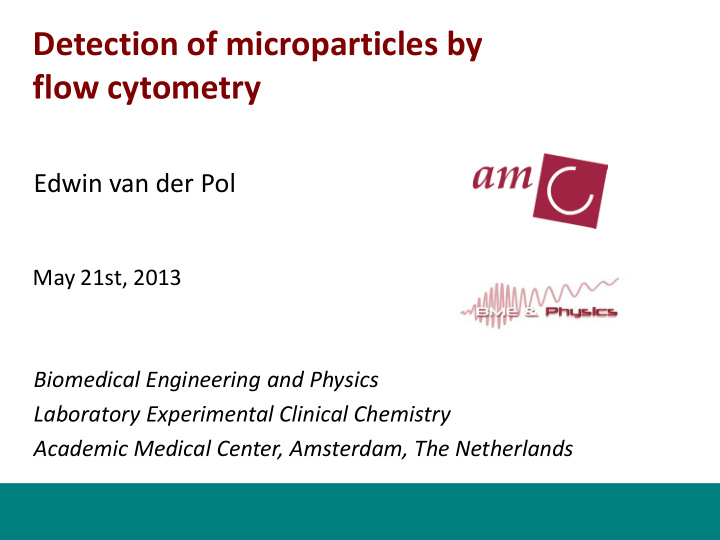



Detection of microparticles by flow cytometry Edwin van der Pol May 21st, 2013 Biomedical Engineering and Physics Laboratory Experimental Clinical Chemistry Academic Medical Center, Amsterdam, The Netherlands 1
Microparticles and flow cytometry vesicles are studied mostly by flow cytometry mechanism causing detection incompletely understood 2
Introduction to flow cytometry fluorescence channels electronics and 488-nm laser computer side scatter detector (SSC) forward scatter detector (FSC) smallest detectable polystyrene bead is 200 nm n = 1.61 image adapted from www.semrock.com 3
Light scattering and the refractive index Polystyrene n = 1.61 bead Silica bead n = 1.45 n core = 1.38 Vesicle n membrane = 1.48 100 nm 4
Problem diameter of vesicles is <300 nm against expectations, vesicles are detected by flow cytometry 5
Goals optimize detection settings measure light scattering power of beads describe measurements by Mie theory determine size of smallest detectable single vesicle investigate role of multiple particles in detection volume by dilution series prospects 6
Methods – optimize flow cytometer settings cell microparticle exosome d = 500 nm d = 50 nm results based on BD FACSCalibur 7
Goals optimize detection settings measure light scattering power of beads describe measurements by Mie theory determine size of smallest detectable single vesicle investigate role of multiple particles in detection volume by dilution series prospects 8
Results – scattering power of polystyrene beads SSC SSC × 1.3E6 = 9
Results – scattering power of silica beads SSC SSC × 1.3E6 = 10
Goals optimize detection settings measure light scattering power of beads describe measurements by Mie theory determine size of smallest detectable single vesicle investigate role of multiple particles in detection volume by dilution series prospects 11
Results – scattering power vs. diameter SSC * 10 nm * van Manen et al., Biophys J (2008) 12 Konokhova et al., J Biomed Opt (2012)
Results – scattering power vs. diameter SSC 10 nm 13
Results – scattering power vs. diameter SSC 10 nm 14
Goals optimize detection settings measure light scattering power of beads describe measurements by Mie theory determine size of smallest detectable single vesicle investigate role of multiple particles in detection volume by dilution series prospects 15
Results – multiple vesicles as single count C = 7 ∙ 10 6 ml -1 C = 9 ∙ 10 5 ml -1 SSC SSC 89-nm silica beads at urine filtered with 220-nm filter concentration 10 10 beads ml -1 concentration ≥ 10 10 vesicles ml -1 16
beam volume ≈ 54 pl At a concentration of 10 10 vesicles ml -1 , >800 vesicles are simultaneously present in the beam. 17
Results – counts from mixtures of beads 18
Results – counts from mixtures of beads 19
Results – counts from mixtures of beads 20
Results – counts from mixtures of beads 21
Results – counts from mixtures of beads 22
Results – counts from urinary vesicles 23
Results – counts from urinary vesicles 24
Conclusion vesicle detection by flow cytometry scattering power related to diameter and refractive index for single beads and vesicles single event signal attributed to scattering from multiple vesicles van der Pol et al., J Thromb Haemost (2012) 25
Prospects of vesicle detection by flow cytometry calibration should be based on experiments and theory size distribution refractive index flow cytometry is good increase sensitivity 26
Sensitivity should be increased 2 2 405 200 0.1 20 “A flow cytometer is unable to detect the smallest vesicle as long as you can detect cells with it.” 27
Acknowledgements Anita Böing More on vesicle detection: Anita Grootemaat edwinvanderpol.com Chi Hau Chris Gardiner Frank Coumans Guus Sturk Henk van Veen Marianne Schaap Martin van Gemert Paul Harrison Rienk Nieuwland Ton van Leeuwen 28
Recommend
More recommend